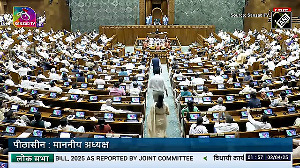Some cigarette-smokers may switch to beedis, or gutka, which is probably not the outcome the health ministry wants, says Devangshu Datta.
 The Union ministry of health is considering a ban on the sale of loose cigarettes, along with a proposal to raise the age limit for buying tobacco and higher fines for smoking in public.
The Union ministry of health is considering a ban on the sale of loose cigarettes, along with a proposal to raise the age limit for buying tobacco and higher fines for smoking in public.
These measures will be greeted with joy by the folks expected to enforce them.
Enforcement will be patchy. You will be able to get a good sense of local governance using this as a benchmark. Better-run cities with lower municipal corruption will also be places where “singles” are harder to buy.
Cigarette smokers form a relatively small, high-value segment of the Indian tobacco market.
More Indians smoke beedis than cigarettes. More chew gutka than smoke. Some cigarette-smokers may switch to beedis, or gutka, which is probably not the outcome the health ministry wants.
What, in fact, does the health ministry want? It is trying to reduce tobacco use in general, and also to reduce passive smoking.
The latter is a noble cause. It should be supported whole-heartedly: non-smokers should not be forced to inhale second-hand smoke simply so that smokers can indulge.
It would be great if the principle was extended to ban the playing of loud devotional prayers and the blocking of roads by religious processions.
Banning smoking in public spaces works. Studies indicate a significant drop in passive smoke-related health issues. In India, such bans have helped to make restaurants, railway stations, etc, less noxious.
I’m more equivocal about reductions in usage. From the state’s perspective, tobacco is a great revenue-earner. However, tobacco usage raises health concerns, given high correlations with cancer, heart disease, lung diseases, etc. The attributable healthcare costs may be higher than the revenue generated.
This assumes, of course, that the healthcare costs are borne by the state, which is not really true in India. The National Family Health Survey estimates 65-70 per cent of India’s healthcare needs are serviced by the private sector.
So the exchequer receives smoking revenues and it doesn’t bear the full healthcare costs. The health ministry should probably lobby for the allocation of a larger chunk of tobacco revenues (and alcohol revenues too!) to fund better infrastructure.
The Union ministry of finance should also encourage smoking until such time as the cost-revenue equation changes.
Mary Poppins would have approved of one of the measures. At 18, an Indian is deemed capable of voting; can be sentenced to death; is considered responsible enough to be licensed to use a dangerous weapon like a car; can make love without being the victim of statutory rape.
Surely, he or she is entitled to commit suicide gradually and with dignity, by ingesting tobacco?
As to the ban on “singles”, there will be “pack-pooling” among moderate smokers, as well as much direct flouting of the law.
Cigarettes will also be sold in smaller packs. The “average” Indian smoker consumes 5.8 cigarettes a day. A pack of three or five cigarettes should work. Moderate smokers may actually increase consumption if they’re buying five cigs at a time instead of one.
Will the ban on singles discourage non-smokers, or ex-smokers, from lighting up the first one? Anecdotally, no. I don’t think even the most sociopathic youngster just buys a single and lights up. Smoking starts socially.
I have spent 35 years quitting smoking. Some quits lasted minutes; others lasted months. My consumption has varied from zero to over 25 a day.
Back in school, I started smoking by bumming “drags” off friends. My restarts after major quits have also involved hitting somebody for a smoke. That pattern, or something similar, is normal, going by chats with other serial quitters.
A ban on singles may prevent the escalation from occasional smoker to regular smoker.
That is, assuming that a ban on singles is enforceable in any real sense. More likely, we will see the evolution of many sophisticated variations on pack-pooling.












 © 2025
© 2025